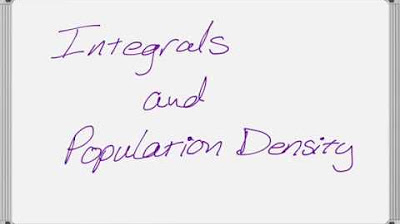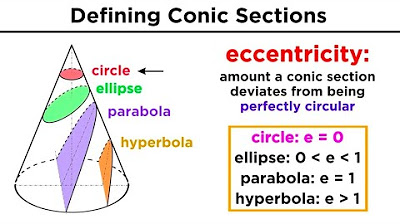Integrals, Population, and Radial Density Functions
TLDRThe video script discusses the concept of integrals population and radial density functions, which are derived from different problems. It uses the example of a city surrounding a circular lake with a radius of 1.5 miles. The population density decreases with distance from the lake's center, following a formula of 6,000 people per square mile over 5 plus the radius (R). To find the total population, the script outlines a method involving slicing the city into concentric circles, calculating the area of each slice, and multiplying by the population density. This process is eventually summarized into an integral formula: the integral from A to B of 2πR times rho(R) dR, where A is the starting radius, B is the ending radius, and rho(R) is the population density at a radius R from the center. The video concludes with an approximate total population of the city, which is around seventy thousand four hundred eighty people.
Takeaways
- 🏙️ The problem involves calculating the total population of a city that surrounds a circular lake, with the city's outer edge being 6 miles from the lake's center.
- 📏 The city's population density, denoted as Rho of R, decreases with distance from the lake's center, following the formula 6,000 / (5 + R) people per square mile.
- 📊 To find the total population, a Riemann sum approach is used, which involves slicing the city into concentric circles and then analyzing each slice.
- 🔵 The city is divided into n slices, each with a radius determined by the larger of the two radii defining the slice, leading to a series of radii R1, R2, ..., Rn.
- 🟢 The area of each slice is calculated using the formula 2πR * ΔR, where R is the radius of the slice and ΔR is the distance between slices.
- 🔵 The population in each slice is found by multiplying the area of the slice by the population density at that radius.
- 📐 As the number of slices (n) approaches infinity, the summation of populations becomes an integral, which is a more efficient way to calculate the total population.
- ∫ The integral formula to find the total population from a radial density function is ∫[A, B] 2πR * rho(R) dR, where A is the starting radius and B is the ending radius of the city.
- 📐 The bounds for the integral are determined by the radius of the lake (1.5 miles) and the outer edge of the city (6 miles).
- 🧮 The final calculation of the integral using the given radial density function yields an approximate total population of seventy thousand four hundred eighty people.
- 📈 Understanding the process of how to arrive at the integral is important, even though in practice one might directly use the integral formula for efficiency.
- 📚 The video script emphasizes the importance of knowing the process behind the integral calculation, which can be beneficial for solving similar problems in the future.
Q & A
What is the shape of the city discussed in the video?
-The city is circular and surrounds a lake.
What is the radius of the lake in the city?
-The radius of the lake is 1.5 miles.
How is the population density of the city described?
-The population density, denoted as Rho of R, decreases as one moves farther from the center of the lake, following the formula 6,000 / (5 + R) people per square mile.
What is the outer radius of the city from the center of the lake?
-The outer radius of the city from the center of the lake is 6 miles.
What method is used to calculate the total population of the city?
-The method used to calculate the total population is the Riemann sum approach, which involves slicing the city into concentric circles and analyzing each slice.
How are the concentric circles visualized in the video?
-The concentric circles are visualized using GeoGebra to create graphics.
What is the term used for the area between the lake and the city?
-The area between the lake and the city is referred to as 'dead space' where no people live.
How is the area of each slice calculated in the Riemann sum approach?
-The area of each slice is calculated by multiplying the circumference of the circle (2 * pi * R) by the thickness of the slice (Delta R).
What is the formula used to find the population in each strip of the city?
-The population in each strip is found by multiplying the area of the strip (2 * pi * R * Delta R) by the population density at that radius (Rho of R).
What is the final integral formula used to find the total population of the city?
-The final integral formula used is the integral from A to B of 2 * pi * R * rho(R) * dR, where A is the starting radius, B is the ending radius, and rho(R) is the population density function.
What was the approximate total population calculated for the city?
-The approximate total population calculated for the city is about seventy thousand four hundred eighty people.
What is the general approach for finding the population from a radial density function?
-The general approach is to use the integral from the starting radius (A) to the ending radius (B) of 2 * pi * R * rho(R) * dR, where rho(R) is the population density function.
Outlines
🌐 Understanding Radial Density Functions and Calculating Total Population
This paragraph introduces the concept of radial density functions and their application in calculating the total population of a city surrounding a circular lake. The city's population density decreases with distance from the lake's center, represented by the function Rho of R, which equals 6,000 over (5 + R) people per square mile. The challenge is to find the total population within the city limits, which extend from 1.5 miles to 6 miles from the lake's center. To solve this, a visual approach using concentric circles is adopted, eventually leading to a summation that represents an integral. The process involves calculating the area of each concentric slice and multiplying it by the corresponding population density, which is then summed up to find the total population.
🧮 Summarizing the Process for Calculating Population Using Radial Density Functions
The second paragraph summarizes the process for calculating the total population from a radial density function. It emphasizes that the integral from the starting radius (A) to the ending radius (B) of two times PI times R times the density function (rho of R) with respect to R (dr) will yield the total population. The paragraph also provides the specific function used in the example, which is Rho of R equals 6,000 over (5 + R). The integral is then evaluated to find that approximately 70,480 people live in the city. The paragraph concludes with a general formula for calculating population using radial density functions, which is integral from A to B of two PI R times rho of R dr, where A is the starting radius and B is the ending radius of the city.
Mindmap
Keywords
💡Integrals
💡Radial Density Functions
💡Population Density
💡Riemann Sum
💡Concentric Circles
💡Circumference
💡Summation
💡Delta R
💡Limits
💡Total Population
💡GeoGebra
Highlights
The video discusses integrals population and radial density functions, which come from different problems.
The problem involves a city around a circular lake with a radius of 1.5 miles and the city extends up to 6 miles from the lake's center.
The population density decreases as the distance from the lake's center increases, a common occurrence in real life.
The population density function is given by Rho of R = 6,000 / (5 + R) people per square mile.
To find the total population, a Riemann sum approach is used by slicing the city into concentric circles.
Each slice is considered as a rectangle when Delta R approaches zero.
The area of each slice is calculated using the formula 2 * pi * R * Delta R, where R is the radius of the slice.
The population in each slice is found by multiplying the area by the population density.
The total population is obtained by summing the populations of all slices, which leads to an integral as the number of slices increases.
The integral to find the total population is the integral from A to B of 2 * pi * R * rho(R) * dR, where A and B are the radii bounds.
The final integral used in the video is the integral from 1.5 to 6 of 2 * pi * R * (6,000 / (5 + R)) * dR.
The evaluation of the integral gives an approximate total population of 70,480 people in the city.
A general formula is provided for finding the population from a radial density function: the integral from A to B of 2 * pi * R * rho(R) * dR.
The process of finding the total population involves understanding the Riemann sum approach, setting up the integral, and evaluating it.
The video provides a step-by-step explanation of the process, making it easier to understand the concept of radial density functions and their application.
The use of GeoGebra to create graphics helps visualize the problem and the slicing of the city into concentric circles.
The video emphasizes the importance of understanding the process even though eventually one might directly jump to the integral for efficiency.
The problem-solving approach demonstrated in the video can be applied to similar radial density function problems in the future.
Transcripts
Browse More Related Video

2021 AP Calculus AB Free Response #1 Solutions (First Administration)

Integrals, Population, and Density Functions

How to find the radius when the area and circumference are changing at the same rate

Worked example: problem involving definite integral (algebraic) | AP Calculus AB | Khan Academy

Why Most Humans Live Inside This Small Circle

Graphing Conic Sections Part 1: Circles
5.0 / 5 (0 votes)
Thanks for rating: